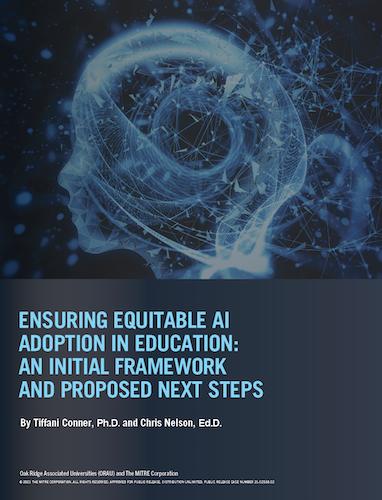The presence and use of technology in the classroom has accelerated rapidly in response to the ongoing coronavirus pandemic.
A news release from Oak Ridge Associated Universities stated, "But what does technology look like in the post-pandemic landscape? Can technology be effectively deployed to better use teachers’ time, while also ensuring every student is equitably engaged in their own education?"
Answers to both questions may be found in the use of artificial intelligence (AI). ORAU and the MITRE Corp. partnered in 2021 on a long-term project to research and ultimately improve the use of AI in education.
The team’s first deliverable was a paper, "Ensuring Equitable AI Adoption in Education: An Initial Framework and Proposed Next Steps", lead authors of which were Tiffani Conner, ORAU evaluation specialist, and Chris Nelson, ORAU program manager for K-12 Science, Technology, Engineering and Math (STEM) education.
The paper was developed from input gathered in focus groups with teachers, school administrators, district administrators and a state-level science coordinator. Data gathered from the focus groups informed a webinar featuring five experts on the topic of AI in education. All of the input, along with a literature review, was used to identify various needs for AI in education and to lay out next steps for the ORAU/MITRE partnership.
“We’ve laid a great foundation for something that we can build upon,” Nelson said in the news release, “particularly the idea of launching pilot programs for boots on the ground case studies of AI in education technologies in the classroom.”
The paper authors made five recommendations to reduce barriers to AI adoption in the classroom, including focusing on education and empowerment, clear communication, inclusive development teams, teacher engagement and collective decision making, Nelson said in the release.

Some of the recommendations were discussed in depth during a conversation for an episode of "Further Together," the ORAU podcast that featured experts from both ORAU and MITRE, along with a teacher who participated in one of the focus groups mentioned earlier.
Teacher engagement was one of the topics discussed.
“I think as a teacher I was nervous,” Tracy Glazier, a math teacher at Herndon High School in Fairfax County, Va., about participating in a focus group on AI in education, stated in the news release. “Everybody is when they start thinking about robots replacing humans and what that will look like in a field where I feel like teaching is such a blend of art and science and wondering how AI would fit into that. I was very curious.”
AI robots replacing humans is not the end goal, stated Guido Zarrella, senior principal AI engineer in the AI and Autonomy Innovation Center within MITRE Labs..
“Teachers are obviously instructors,” he said in the release. “And they do classroom management, personalization of learning plans for students, proctoring tests, grading homework, teaching effective communication skills and demonstrating high-quality values for students. There is this long list of really high-priority responsibilities that a teacher has. It’s not going to be enough to drop a robot in, obviously.”
Rather, Zarrella said there is a lot of technology that can save teacher time across many of their responsibilities, like software with automated scoring algorithms that can be time saving. Other software can ensure the integrity of the testing process or detect plagiarism, help students practice reading or coding, or assist with note taking and speech recognition.
“AI’s influence in the classroom is going to happen through a lot of micro channels, and a lot of small choices or decisions that get made along the way,” he said in the release.
Collective decision making to improve equity also was discussed during the podcast conversation.
While some tools are available and more are surely coming, the equitable use of them is far from automatic. Equitable distribution of AI is going to take intentional work, Bobby Blount, Jr., head of MITRE’s Texas Innovation Hub, stated in the release. Blount also has direct experience working with stakeholders as an elected member of the Northside Independent School District School Board in San Antonio, Texas.
“How we achieve equity is going to take collaboration among not only us as MITRE and ORAU, but also with industry, with vendors that are producing the tools, and with our school districts and teachers all working together,” Blount said in the release.
The focus on equity, working with stakeholders and getting teacher engagement really needs to be happening now, Blount and Zarrella said in the release.
“Deployments of AI in education are not some future concern. They’re happening, kind of automatically. These technologies are inserting themselves in everyday life and in ways that make the implications impossible to miss in schools,” Zarrella said in the release.
“Teachers see those implications firsthand because they are in the classroom working with their students every day,” said Jennifer Tyrell, ORAU senior project manager for K-12 STEM education.
Solutions that help teachers do their job and help students become better educated are most welcome and appreciated, Glazier said in the release.
“Teachers are crazy about finding anything they think will work in their classroom tomorrow,” she said in the release.
The next steps of the ORAU/MITRE partnership focus on future research, public engagement, and public/private partnerships, which means the AI of tomorrow may not be that far away.
MITRE is an American not-for-profit organization with dual headquarters in Bedford, Massachusetts, and McLean, Virginia. Through its public-private partnerships and federally funded R&D centers, it works across government and in partnership with industry to tackle challenges to the safety, stability, and well-being of the nation, its website states.









